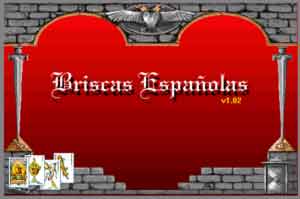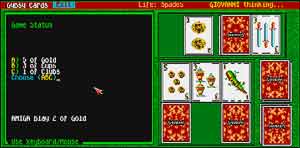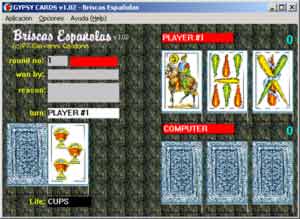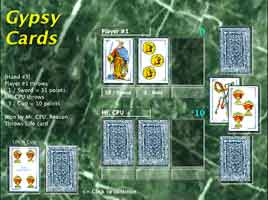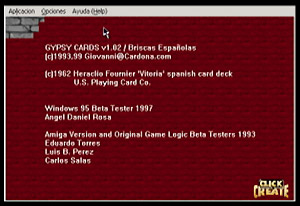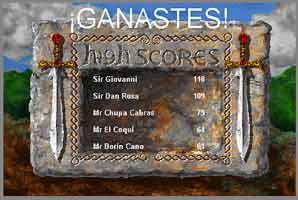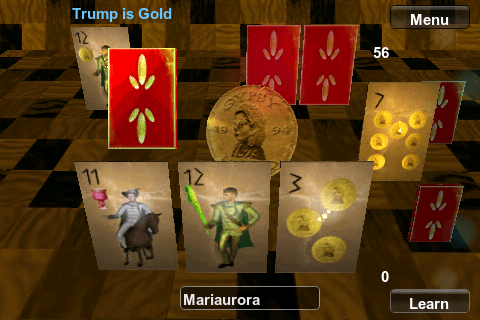|
|
|
It is the year 1993 and Solitaire (and derivates like Klondike) was dominating the cybernetic world. I was wondering that we, Latinos, had a great card game from Spanish origins, named "Briscas", that would be a great idea to bring it to the digital world.
With the emergence of different versions of Solitaire, I asked myself how I could make a unique game experience so that existing card gamers would want to try my game and include it in their gaming arsenal.
- I gave it a personality. In order to evoke the idea of playing inside an old castle, I gave the game a medieval theme, complete with stone wall backgrounds and old English-type letters which helped set the mood. These were displayed across all the screens, including the main and Hi-score screens.
- Since I was targeting the Solitaire gaming audience, I figured that most people either didn't know what Briscas was, or didn't know how to play it. How could I make the game easy to learn for them? How about making a game that taught you how to play while you played? This aspect of the game includes a verbal description of the game while it is being played.
- Is a verbal description during the game enough to teach someone how to play? What if I bring in some visual and audio cues? As I studied the game I found that one of the confusing factors for newcomers was the fact that the Trump Suite changed in every duel. Thus, I implemented an audio and visual cue every time a Trump card is played.
- At least two people are needed to play the game. Although the 1993 version implemented an online gameplay feature (via modem), in order to play the game alone I developed an artificial intelligence logical structure. This is how the "Play vs. the CPU" was born.
| 1997 Distribution |
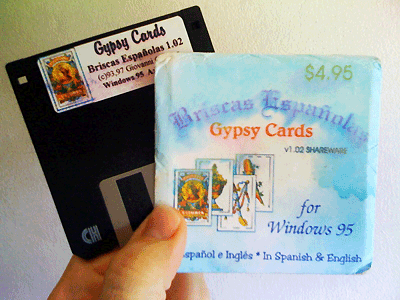 |
| The Windows 95 version, distributed in Puerto Rico by CDWare. This was the version that set the standard for the rest of the Briscas games found nowadays over the internet. |
|
|
|
|
|
|
| This is the main screen for the Amiga version. The game was posted on Aminet in 1994 by a friend Luis Perez. |
|
This is the main screen for the Windows 95-98 and web version. This version was published on ZDNet in 1998 and was awarded 4 stars. |
1993 |
|
1997 |
|
2006 |
|
|
|
|
|
| This is the play area on the Amiga version. The moves where explained on the left side of the screen. |
|
This is the play area on the Windows 95 version. The moves where explained on the upper left side of the screen. |
|
This is the 2006 version. Released on the internet as a Java prototype, it contains the game framework used in the iPhone version. The playing area is a representation of a marble slab with embedded holdplaces for the cards. |
1997 |
|
|
|
This is the Credit screen for the 1997 version. Not that fancy, eh? Remember all those graphics, music, game and installer must fit on a floppy disk (around 1 Meg) |
|
It was 1997, the "Chupacabras" has some relevance back then, so there is a special mention in the Hi-Scores screen, why not? Also the "El Coqui" and "Borin Cano" was there :) |
I understand that all these particularities of the original Gypsy Cards aren't found in any briscas games, at least in 1993. Some of these particularities were somehow implemented and modified by other developers in modern day brisca games, thanks to the path lead by the original "Gypsy Cards". The iPhone version includes 3d rendered suites given as an award for the winner... a concept that you saw here first :)
[Back to Home Page]
|


.jpg)
